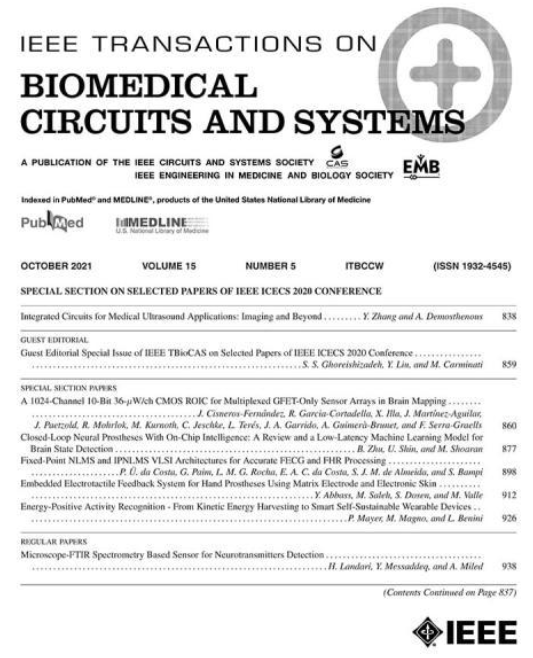A Low-Power ASIC Signal Processor for a Vestibular Prosthesis
IF 4.9
2区 医学
Q2 ENGINEERING, BIOMEDICAL
IEEE Transactions on Biomedical Circuits and Systems
Pub Date : 2016-01-18
DOI:10.1109/TBCAS.2015.2495341
引用次数: 5
Abstract
A low-power ASIC signal processor for a vestibular prosthesis (VP) is reported. Fabricated with TI 0.35 μm CMOS technology and designed to interface with implanted inertial sensors, the digitally assisted analog signal processor operates extensively in the CMOS subthreshold region. During its operation the ASIC encodes head motion signals captured by the inertial sensors as electrical pulses ultimately targeted for in-vivo stimulation of vestibular nerve fibers. To achieve this, the ASIC implements a coordinate system transformation to correct for misalignment between natural sensors and implanted inertial sensors. It also mimics the frequency response characteristics and frequency encoding mappings of angular and linear head motions observed at the peripheral sense organs, semicircular canals and otolith. Overall the design occupies an area of 6.22 mm 2 and consumes 1.24 mW when supplied with ± 1.6 V.用于前庭假体的低功耗ASIC信号处理器
报道了一种用于前庭假体(VP)的低功耗ASIC信号处理器。该数字辅助模拟信号处理器采用TI 0.35 μm CMOS技术制造,设计用于与植入惯性传感器接口,在CMOS亚阈值区域广泛工作。在操作过程中,ASIC将惯性传感器捕获的头部运动信号编码为电脉冲,最终用于在体内刺激前庭神经纤维。为了实现这一点,ASIC实现了坐标系转换,以纠正自然传感器和植入惯性传感器之间的不对准。它还模拟了外围感觉器官、半规管和耳石观察到的角状和线性头部运动的频率响应特性和频率编码映射。总体而言,该设计占地6.22 mm 2,在±1.6 V供电时消耗1.24 mW。
本文章由计算机程序翻译,如有差异,请以英文原文为准。
求助全文
约1分钟内获得全文
求助全文
来源期刊

IEEE Transactions on Biomedical Circuits and Systems
工程技术-工程:电子与电气
CiteScore
10.00
自引率
13.70%
发文量
174
审稿时长
3 months
期刊介绍:
The IEEE Transactions on Biomedical Circuits and Systems addresses areas at the crossroads of Circuits and Systems and Life Sciences. The main emphasis is on microelectronic issues in a wide range of applications found in life sciences, physical sciences and engineering. The primary goal of the journal is to bridge the unique scientific and technical activities of the Circuits and Systems Society to a wide variety of related areas such as: • Bioelectronics • Implantable and wearable electronics like cochlear and retinal prosthesis, motor control, etc. • Biotechnology sensor circuits, integrated systems, and networks • Micropower imaging technology • BioMEMS • Lab-on-chip Bio-nanotechnology • Organic Semiconductors • Biomedical Engineering • Genomics and Proteomics • Neuromorphic Engineering • Smart sensors • Low power micro- and nanoelectronics • Mixed-mode system-on-chip • Wireless technology • Gene circuits and molecular circuits • System biology • Brain science and engineering: such as neuro-informatics, neural prosthesis, cognitive engineering, brain computer interface • Healthcare: information technology for biomedical, epidemiology, and other related life science applications. General, theoretical, and application-oriented papers in the abovementioned technical areas with a Circuits and Systems perspective are encouraged to publish in TBioCAS. Of special interest are biomedical-oriented papers with a Circuits and Systems angle.
 求助内容:
求助内容: 应助结果提醒方式:
应助结果提醒方式:


